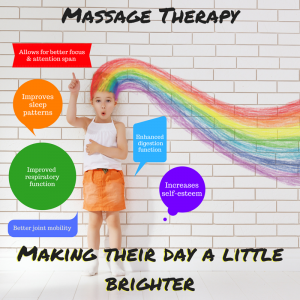
Infant vs. Pediatric Massage: What's the Difference?
By Tina Allen , LMT, CPMMT, CPMT, CIMT
Founder of The Liddle Kidz Foundation
What is the difference between infant and pediatric massage? Is there truly difference ? This all depends how you define the term infant and how you define pediatric. If you are working in a pediatric hospital or healthcare environment, some will say that the word pediatric is an "umbrella" term that covers all of the patients in that facility from birth to age of discharge from the hospital (often 18 years of age). Others use the thinking that there are pediatric populations in the healthcare setting, but that the infant category is limited to the age of 0 to 12 months, and thus often requires different stages of care. When it comes to massage therapy, there are some very clear distinctions between the two modalities of infant massage and pediatric massage.
What is Infant Massage?
Infant Massage is an ancient tradition of providing nurturing touch as a way of communicating and bonding with baby. Massage can help foster mutual trust and understanding between caregiver and child. Infant massage is composed oftechniques which are utilized with babies from approximately three weeks of age and may be adapted onward. Yes, absolutely, parents and caregivers should use nurturing touch with their child as soon as they are born. Specialized massage techniques are used with babies born prematurely. However, generally speaking, for healthy children we would use the three week starting period.
Infant massage for healthy babies is typically administered by parents and caregivers who have been trained by certified infant massage teachers in private and group sessions. Infant massage teachers teach parents and caregivers to use gentle massage techniques, understand their baby's individual cues and methods of communication to enhance many life changing benefits. Clinical research has shown that massaging baby can aid in their healthy growth and development, may soothe common discomforts, promote restful sleep for the infant (and in turn the caregivers), and can increase healthy attachment and bonding.
Evidence has also shown babies who receive massage have increased weight gain, improved immune function and decreased stress hormones. When parents provide massage, their babies may experience optimal neurological function and improved digestion. The benefits achieved with the use of infant massage therapy are needed to encourage appropriate emotional, cognitive and physical development.
What is Pediatric Massage?
It is somewhat easier to think that a child who has been hospitalized or diagnosed with a debilitating medical condition may benefit from the use of massage therapy. However, healthy children have just as many indications for receiving pediatric massage therapy. Children need nurturing touch to grow and reach their full potential. With massage, we aid in their restful sleep, stress reduction and comfort growing pains. In studies performed by massage therapy researchers, reported benefits for typically developing children also include improved concentration, increased focus and decreased aggression. Some researchers even report that children who have received massage therapy for a regular period of time may show increased IQ.
Research has indicated that massage therapy can ease both physical symptoms, as well as emotional discomforts associated with pediatric medical conditions. Immediately after receiving massage, children with mild to moderate juvenile rheumatoid arthritis notice decreased anxiety and stress hormone (cortisol) levels. For young patients with Autism, their aversion to touch decreases with massage, while their ability to focus increases. Pediatric patients with cystic fibrosis report feeling less anxious and their ability to breathe and pulmonary functions improved.
With pediatric massage therapy, safety and knowledge is important. There is a common misconception that child clients are the same as adults, just smaller in size. This is not true. There are many developmental considerations to think about. With pediatric massage you are using evidence-based techniques to best care for a child who may need healthy touch as a means of easing stress and anxiety associated with bullying at school, or to minimize pain due to their specific medical diagnosis. This professional modality uses unique methods of communication and connection to help children feel safe, respected and open to receiving nurturing touch.
https://www.massagetoday.com/articles/14586/Infant-vs-Pediatric-Massage-Whats-the-Difference
Other Pediatric Massage Resources:
Pediatric Massage Therapy Research: A Narrative Review
Randomized Controlled Trials of Pediatric Massage: A Review
Touch Research Institute Articles
Massage Therapy Can Support Trauma Healing

